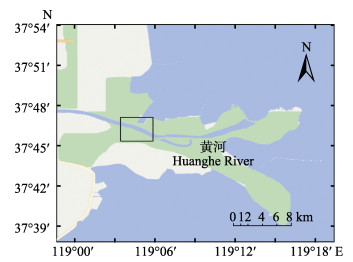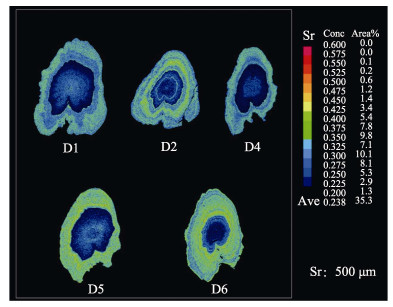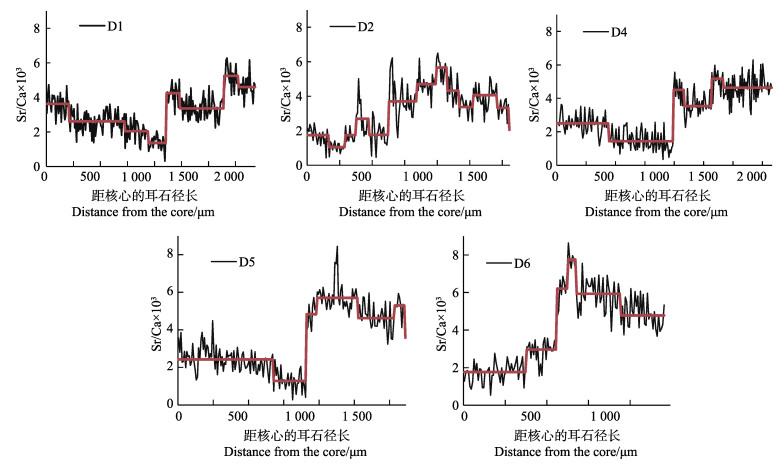2. 中国水产科学研究院淡水渔业研究中心 中国水产科学研究院长江中下游 渔业生态环境评价与资源养护重点实验室 江苏 无锡 214081
2. Freshwater Fisheries Research Center, Chinese Academy of Fishery Sciences, Key Laboratory of Ecological Environment and Resources of Inland Fisheries, Wuxi Jiangsu 214081, China
刀鲚(Coilia nasus)是一种极为名贵的洄游性经济鱼类。20世纪60年代黄河刀鲚年产量可达1500 t (蔡德霖等, 1980),是黄河下游的重要物种,但受过度捕捞、水利工程、黄河断流等影响,山东东平湖产卵场已被严重破坏,黄河口及河段很长时间内已无刀鲚分布。近年来,根据山东省淡水渔业研究院对黄河口渔获物调查数据及对当地渔民的走访发现,黄河刀鲚再一次在黄河下游出现,但资源量依然较低。随着刀鲚经济价值的提高,相关针对资源保护的科研工作正在开展,但多数集中于长江河段。近日,黄河流域生态保护和高质量发展已上升为国家战略,渔业资源的合理开发和保护显得尤为重要,但黄河河段刀鲚研究依然空白,相关工作严重滞后。
耳石微化学分析能有效地反演洄游性鱼类的“履历”,在耳石中,Sr、Ca元素沉积变化被用作研究不同盐度海、淡水生境条件的“指纹”(窦硕增等, 2011;杨健等, 2010; 姜涛,2014; 姜涛等, 2016),结果具有独特的生境相关性及客观性的优势,即使仅有1尾样本也能有效把握其生境状态(徐钢春等, 2014)。姜涛等(2013)通过分析鄱阳湖刀鲚耳石微化学特征发现,鄱阳湖内存在2种不同生活史的刀鲚群体;卢明杰等(2015)研究大辽河口红狼牙
刀鲚于2016年5月采自黄河垦利段(图 1),主要捕捞网具为刺网。共取得刀鲚5尾(表 1),捕获后置于–20℃冷冻待用。解剖后取出矢耳石,为降低误差,统一使用左矢耳石进行分析,使用去离子水清洗耳石表面杂质及薄膜,置于室温晾干待用。

|
图 1 刀鲚采样地点 Fig.1 The sampling sites of C. nasus |
|
|
表 1 刀鲚采样资料 Tab.1 Sample details of C.nasus from the Kenli section of the Huanghe River |
耳石样品使用环氧树脂包埋固定制成树脂块,然后将树脂块固定于载破片上,凝固后切去多余树脂部分。使用Discoplan-TS研磨机进行粗磨至耳石刚要暴露,再用1200目的砂纸精磨至耳石核心完全暴露,最后采用Roto Pol-35磨抛机配合抛光液抛光至耳石表面无划痕。处理好的耳石置于Milli-Q超纯水中超声清洗5 min,于烘箱内38℃过夜烘干。
1.2 耳石微化学分析参考Yang等(2006)的方法,使用X射线EPMA电子探针微区分析仪(JXA-8100,日本)分析耳石样品。自耳石核心沿最长径至耳石边缘的一条直线进行定量线分析(line transect analysis)。EPMA加速电压和电子束电流分别为15 kV和2×10–8 A,束斑直径为5 μm,每点驻留时间为15 s,以10 μm为间隔连续打点测定。标准样品取用碳酸钙(CaCO3)和钛酸锶(SrTiO3)。定量线分析完成后,再对耳石样品进行面分布分析(mapping analysis)。此时,EPMA加速电压和电子束电流分别为15 kV和5×10–7 A,束斑直径为5 μm,像素为7 μm× 7 μm,每点驻留时间为30 ms。
1.3 数据处理使用Excel 2010软件进行数据处理,使用SPSS 17.0软件进行非参数检验(Mann-Whitney U-test)。引入进行格局转变(Regime shifts)分析的STARS方法(Sequential T-test Analysis of Regime Shifts),当多于1个连续点出现显著变化(基于数据方差和t检验的P值),将视为“转变”,生成新的移动平均(Rodionov, 2004; Rodionov et al, 2005)。本研究设定截断长度为10,Huber权重为1,置信度P为0.1,按照惯例Sr/Ca值标准化为Sr/Ca×103。
2 结果 2.1 定量线分析比较定量线分析结果显示(表 2),每尾刀鲚生长阶段不尽相同。本研究中,根据Sr/Ca值可分为不同生活史阶段,且相邻不同阶段差异显著(P < 0.05, Mann-Whitney U-test)(表 2)。个体D1的Sr/Ca值可分为4个阶段,分别为从核心沿矢状面像边缘至240 μm耳石径的低值区域,平均值为3.63±0.61;241~1320 μm区域,平均值为2.24±0.72;1321~1960 μm区域,平均值为3.57±0.68;1961~2310 μm区域,平均值为4.90±0.69。个体D4可分为3个阶段,0~1180 μm区域,平均值为1.90±0.76;1181~1570 μm区域,平均值为3.83±0.74;1571~2190 μm区域,平均值为4.82±0.77。个体D5可分为3个阶段,0~1080 μm区域,平均值为2.15±0.78;1081~1520 μm区域,平均值为5.61±0.75;1521~1930 μm区域,平均值为4.74±0.70。个体D6可分为3个阶段,0~660 μm区域,平均值为2.13±0.77;661~1120 μm区域,平均值为6.17±0.99;1121~1440 μm区域,平均值为4.84±0.76。图 2以折线图的形式表现不同类型黄河刀鲚与东平湖刀鲚耳石矢状面从核心(0 μm)到边缘定量线分析Sr/Ca值变化对比。个体D2线分析显示,生活史无规律,故不做阶段划分。
|
|
表 2 刀鲚耳石锶钙比微化学 Tab.2 Fluctuation of Sr and Ca microchemistry in otoliths of C.nasus |

|
图 2 耳石矢状面二维Sr含量分布 Fig.2 Two-dimensional imaging using mapping analysis of the Sr in otoliths of C.nasus Sr:锶;Conc:Sr浓度;Area/%:面积占比;Ave:Sr浓度表平均值 Sr: Strontium; Conc: Concentration of Sr; Area/%: The area proportion; Ave: The average concentration of Sr |
面分析的结果更能直观清晰地显示出黄河刀鲚个体的生境履历。Yang等(2011)关于长江刀鲚的研究表明,刀鲚对应淡水、淡咸水、海水生境的Sr/Ca有十分明显的微化学特征,具体表现为 < 3(蓝色)、3~7(黄绿色)、> 7(黄红色),Ⅲ类水体中,Sr/Ca×103值平均为海水区8.3±4.5、河口区5.6±1.1、淡水区2.7±1.5 (Sector et al, 2000; Yang et al, 2011)。个体D2核心区域表现为蓝色,随着个体的生长,黄色、蓝色交替出现;个体D1、D4核心区表现为蓝色,外缘区域表现为蓝绿色;个体D5、D6核心区域表现为Sr值较低的蓝色区域,随着刀鲚生长,耳石外围逐渐形成较为明显的黄色圆环,表明其已经进入Sr值较高的生活环境。
3 讨论耳石中元素Sr和Ca浓度比值的变化在国内外研究中已经被广泛应用于鱼类生活史中(Wells et al, 2000; Gillanders et al, 2005; Arai et al, 2006; 陈婷婷等, 2016; 熊瑛等, 2014; 丛旭日等, 2019),但有关黄河刀鲚的研究尚未见报道。蔡德霖等(1980)研究表明,黄河刀鲚的生活史特征较为单一,成鱼每年4—5月沿黄河溯河洄游至东平湖,6—7月产卵,等孵化后于次年初进入黄河口海域。由此可见,历史上黄河垦利段是刀鲚重要的洄游通道,东平湖是主要产卵场,黄河口海域为索饵场、越冬场。对于现阶段黄河刀鲚是否为洄游型刀鲚的争论较大,有的学者认为,黄河垦利段已不存在洄游型刀鲚,其再次出现是由于东平湖内定居型刀鲚被动进入黄河所致,但此观点缺乏充足论据。本研究从耳石微化学的角度出发,获得的结果客观真实地反映出黄河垦利段刀鲚的生境利用情况,为证明“三场一通道”依然分布洄游型刀鲚及其生活史多样性提供了理论基础。
本研究结果显示,黄河垦利段刀鲚的生境履历具有复杂性的特点。Brown等(2009)研究表明,海水的Sr/Ca×103值相对稳定(8.17~8.87),而河流(0.27~19.18)和淡水湖泊波动较大(0.20~5.02)。然而,孙珊等(2019)和徐江玲(2007)研究表明,受调水、调沙的影响,黄河口区域盐度的时空变化较为剧烈,调水、调沙前后表层盐度变化范围约为6~25,垂直方向亦波动较大,故不能通过传统研究方法判断黄河刀鲚是否到达盐度较高的海水区域。本研究的个体可分为2种类型。个体D2属于第Ⅰ类型,其生活史较复杂,淡水孵化后其生长轨迹多次往返于淡水—半咸水生境,格局发生多次转变,不具备洄游型刀鲚应有的规律性特征,此外,耳石边缘Sr/Ca值反映样品被捕获时的环境条件,个体D2耳石边缘Sr/Ca值(< 3)较其他个体低,这是因为Sr/Ca值变化存在时滞效应,表明个体D2进入此水域的时间较短,耳石尚未响应生境的变化。大麻哈鱼(Oncorhynchus keta)耳石的此种效应可持续12 d (王臣等, 2015);李孟孟等(2017)对长江安庆江段刀鲚的研究也存在此种效应。个体D1、D4、D5和D6属于第Ⅱ类型,孵化和早期的生活均在盐度较低的淡水中进行,淡水生境履历较长。线分析显示,个体D1和D4能达到的Sr/Ca最大值分别为6.50和6.29,并未达到海水区的平均值(8.3)。D5和D6个体Sr/Ca的最大值虽然达到8.44和8.63,但由于黄河口区域盐度二维变化受调水、调沙影响较大,尚不能判断其生境履历已延伸到盐度较高的海水区。此外,个体D5虽然进入Sr/Ca值较高的区域生活,但停留时间较为短暂。STARS法计算显示,个体D5没有形成“转变”,而个体D6形成了“转变”(图 3)。

|
图 3 不同类型刀鲚耳石矢状面从核心(0 μm)到边缘定量线分析Sr/Ca值的变化 Fig.3 Fluctuation of otolith Sr/Ca concentration ratios along line transects from the core (0 μm) to the edge in otoliths of C. nasus |
通过EPMA技术分析显示,本研究首次直观地了解黄河口刀鲚的生境履历特征。以个体D1、D4、D5和D6为代表的群体孵化、育幼阶段均在淡水中进行,索饵阶段进入Sr/Ca值较高的河口区,个体的Sr/Ca值均有一个从低值阶段(< 3)突然升高至高值阶段(3~7)的变化,根据对长江刀鲚多年研究,第Ⅰ阶段到第Ⅱ阶段突越性的变化(从淡水进入半咸水生活)对洄游性刀鲚来说是至关重要的(姜涛等, 2013),个体D1、D4、D5和D6变化剧烈,都存在突越性变化,表明其主动进入盐度较高的区域,符合洄游型刀鲚的特征。以个体D2为代表的群体生活史较为复杂,无规律,推测可能是由于当年东平湖汛期放水而被动进入黄河的定居型刀鲚,其生活史轨迹受黄河水流的影响较大,虽然该个体无洄游型刀鲚的明显特征,但据徐钢春等(2014)、李孟孟等(2017)对于长江刀鲚的研究表明,长颌鲚(Coilia nasus)与短颌鲚(Coilia brachygnathus)均参与江海洄游,长江安徽和县江段的短颌鲚也存在洄游个体,而短颌鲚属于湖泊定居型刀鲚,分子层面上基于Cyt b和D-loop序列的分子标记亦不能区分洄游型刀鲚与定居型刀鲚(孙超等, 2018),表明刀鲚具有较强的环境适应性,也表明汛期从东平湖进入黄河的定居型刀鲚经过自然演化,一旦具备条件也会进行溯河洄游。此外,个体D1和D5核心区域的Sr/Ca×103值较高(> 3),D2、D4和D6核心区域的Sr/Ca×103值较低(< 3),这也在某种程度上反映了存在个体起源于不同产卵场的可能性。姜涛(2014)研究发现,耳石的长度与鱼体的年龄有非常高的相关性,可以作为估算刀鲚生活史的时间尺度,姜涛(2014)的研究还表明,黄河刀鲚大约在1龄离开淡水生活[区域为(980±111) μm]。本研究中,个体D1(1210 μm)、D4(1160 μm)和D5(1080 μm)均符合这一特征, 均在1龄或1龄+离开淡水生活, 但个体D2(590 μm)和D6(560 μm)在不到1龄就已经离开淡水生活。其中,推测个体D2受黄河水流的影响,尚未具备洄游特征,而个体D6显示出黄河刀鲚可能来自不同的群体,也表明其较强的环境适应性,与Jiang等(2014)在2009年捕获的10尾黄河刀鲚耳石微化学分析结果相似,视其来源于同一群体。但在本研究中,黄河刀鲚个体表现出不同的生活史特征,2013年南水北调东线正式通水至今,东平湖定居型刀鲚已成为当地主要经济性鱼类,推测东平湖与黄河联通河道不定期泄洪致使一部分定居型刀鲚进入黄河,是黄河刀鲚的资源群体组成较为复杂、多样的重要原因。
随着黄河流域生态保护和高质量发展国家战略的提出,黄河流域渔业资源的可持续发展变得尤为重要。近年来,由于产卵场被破坏、闸坝工程的兴建、过度捕捞等因素,黄河刀鲚的种群结构及生活史演变较大。根据调查,黄河与东平湖之间的联通河道大清河只有在每年夏季泄洪时才开闸放水,目前,尚不能证明东平湖具备产卵场的条件,在今后的工作中,应进一步对早期发育阶段的刀鲚进行基础生物学及耳石微化学的分析,结合年龄结构、生长死亡参数及亲体产卵状况更为精确的掌握东平湖、黄河下游及河口地区刀鲚生活史,监测其是否形成固定的洄游种群,从而验证历史上东平湖、黄河山东段、黄河口是刀鲚洄游的“三场一通道”。相关部门也可以利用已有先例的河坝鱼道技术,保护洄游通道及产卵场的生态功能,确保种群正常的繁衍。
ARAI T, YANG J, MIYAZALD N. Migration flexibility between freshwater and marine habitats of the pond smelt Hypomesus nipponensis. Journal of Fish Biology, 2006, 68(5): 1388-1398 DOI:10.1111/j.0022-1112.2006.01002.x |
BROWN R J, SEVERIN K P. Otolith chemistry analyses indicate that water Sr : Ca is the primary factor influencing otolith Sr: Ca for freshwater and diadromous fish but not for marine fish. Canadian Journal of Fisheries and Aquaticsciences, 2009, 66(10): 1790-1808 DOI:10.1139/F09-112 |
CAI D L, JI D C, ZHOU C W. An ecological investigation and fishery of the anchovy (Coiliaectenes Jordan et Seale) in the lower Yellow River. Journal of Shandong University (Natural Science), 1980(2): 97-107 [蔡德霖, 汲岱昌, 周才武. 黄河下游刀鲚的生态和渔业概况. 山东大学学报(自然科学版), 1980(2): 97-107] |
CHEN T T, JIANG T, LU M J, et al. Microchemistry analysis of otoliths of Colia nasus and Colia brachygnathus from the Jingjiang section of the Yangtze River. Journal of Lake Sciences, 2016, 28(1): 149-155 [陈婷婷, 姜涛, 卢明杰, 等. 基于耳石微化学的长江靖江段长颌鲚与短颌鲚生境履历重建. 湖泊科学, 2016, 28(1): 149-155] |
CONG X R, LI X Q, DONG G C, et al. Anadromous tapertail anchovy Coilia nasus is still found in Dongping Lake. Chinese. Journal of Fisheries, 2019, 32(5): 55-59 [丛旭日, 李秀启, 董贯仓, 等. 东平湖仍有洄游性刀鲚分布的实证研究. 水产学杂志, 2019, 32(5): 55-59 DOI:10.3969/j.issn.1005-3832.2019.05.009] |
DOU S Z, YOKOUCHI K, YU X, et al. Reconstructing migratory history of fish using otolith strontium: Calciums ratios by EPMA: A case sdudy. Oceanologia et Limnologia Sinica, 2011, 42(4): 512-520 [窦硕增, 横内一樹, 于鑫, 等. 基于EPMA的耳石Sr : Ca比分析及其在鱼类生活履历反演中的应用实例研究. 海洋与湖沼, 2011, 42(4): 512-520] |
GILLANDERS B M. Otolith chemistry to determine movements of diadromous and freshwater fish. Aquatic Living Resources, 2005, 18(3): 291-300 DOI:10.1051/alr:2005033 |
JIANG T, LIU H B, LU M J, et al. The comparison of different pre-treatment methods for acquiring otolith annuli of Coilia nasus. Progress in Fishery Sciences, 2016, 37(2): 62-67 [姜涛, 刘洪波, 卢明杰, 等. 几种前处理方法所获刀鲚(Coilia nasus)耳石年轮的效果比较. 渔业科学进展, 2016, 37(2): 62-67] |
JIANG T, LIU H B, SHEN X Q, et al. Life history variations among different populations of Coilia nasus along the Chinese Coast inferred from otolith microchemistry. Journal of the Faculty of Agriculture Kyushu University, 2014, 59(2): 383-389 DOI:10.5109/1467650 |
JIANG T, ZHOU X Q, LIU H B, et al. Two microchemistry patterns in otoliths of Coilia nasus from Poyang Lake, China. Journal of Fishery of China, 2013, 37(2): 239-244 [姜涛, 周昕期, 刘洪波, 等. 鄱阳湖刀鲚耳石的两种微化学特征. 水产学报, 2013, 37(2): 239-244] |
JIANG T. Study on migratory ecology of Coilia fish in Chinese waters inferred from otolith morphometric and microchemial characteristics. Doctoral Dissertation of Nanjing Agricultural University, 2014 [姜涛. 基于耳石形态和微化学特征的我国鲚属鱼类洄游生态学研究. 南京农业大学博士研究生学位论文, 2014]
|
LI M M, JIANG T, CHEN T T, et al. Otolith microchemistry of the estuarine tapertail anchovy Coilia nasus from the Anqing section of the Yangtze River and its significance for migration ecology. Acta Ecologica Sinica, 2017, 37(8): 2788-2795 [李孟孟, 姜涛, 陈婷婷, 等. 长江安庆江段刀鲚耳石微化学及洄游生态学意义. 生态学报, 2017, 37(8): 2788-2795] |
LI X Q, CONG X R, SHI J H, et al. Feasibility analysis of releasing individuals of Aristichthys nobilis identification based on otolith Sr markers. Journal of Lake Sciences, 2017, 29(4): 914-922 [李秀启, 丛旭日, 师吉华, 等. 耳石锶标记在识别鳙(Aristichthys nobilis)放流个体的可行性. 湖泊科学, 2017, 29(4): 914-922] |
LU M J, LIU H B, JIANG T, et al. Preliminary investigations on otolith microchemistry of Odontamblyopus rubicundus in the Daliao River Estuary, China. Marine Fisheries, 2015, 37(4): 310-317 [卢明杰, 刘洪波, 姜涛, 等. 大辽河口红狼牙  虎鱼耳石微化学的初步研究. 海洋渔业, 2015, 37(4): 310-317 DOI:10.3969/j.issn.1004-2490.2015.04.003] 虎鱼耳石微化学的初步研究. 海洋渔业, 2015, 37(4): 310-317 DOI:10.3969/j.issn.1004-2490.2015.04.003] |
RODIONOV S N, OVERLAND J E. Application of a sequential regime shift detection method to the Bering Sea ecosystem. ICES Journal of Marine Science, 2005, 62(3): 328-332 DOI:10.1016/j.icesjms.2005.01.013 |
RODIONOV S N. A sequential algorithm for testing climate regime shifts. Geophysical Research Letters, 2004, 31(9): 111-142 |
SECTOR D H, ROOKER J R. Is otolith strontium a useful scalar of life cycles in estuarine fishes?. Fisheries Research, 2000, 46(1): 359-371 |
SI F, REN J G, WANG Q L, et al. Strontium marking on otoliths of Paralichthys olivaceus based on immersion experiments. Journal of Fishery Sciences of China, 2019, 26(3): 534-545 [司飞, 任建功, 王青林, 等. 基于浸泡法的牙鲆耳石锶标记技术研究. 中国水产科学, 2019, 26(3): 534-545] |
SUN C, LIU H B, JIANG T, et al. Comparison of D-loop and Cytochrome b sequences among different Coilia species and their potential use in analysis for the identification of species at early life stages. Progress in Fishery Sciences, 2018, 39(5): 27-35 [孙超, 刘洪波, 姜涛, 等. 不同鲚属鱼类Cyt b和D-loop序列的比较及其判别早期生活史个体的潜力分析. 渔业科学进展, 2018, 39(5): 27-35] |
SUN S, SU B, LI F, et al. Effects of water and sediment discharge regulation on environment in the Yellow River Estuary and adjacent waters. Marine Environment Science, 2019, 38(3): 399-406 [孙珊, 苏博, 李凡, 等. 调水调沙对黄河口及邻近海域环境状况的影响. 海洋环境科学, 2019, 38(3): 399-406] |
WANG C, LIU W, ZHAN P R, et al. Exogenous Sr2+ sedimentation on otolith of chum salmon embryos. Chinese Journal of Applied Ecology, 2015, 26(10): 3189-3194 [王臣, 刘伟, 战培荣, 等. 外源Sr2+在大麻哈鱼胚胎耳石上的沉积. 应用生态学报, 2015, 26(10): 3189-3194] |
WELLS B K, BATH G E, THORROLD S R, et al. Incorportation of strontium, cadmium, and barium in juvenile spot (Leiostomus xanthurus) scales reflects water chemistry. Canadian Journal of Fisheries and Aquatic Science, 2000, 57(10): 2122-2129 DOI:10.1139/f00-178 |
XIONG Y, LIU H B, LIU P T, et al. Reconstructing habitat history of Larimichthys polyactis in Lüsi coastal waters of Jiangsu Province, China based on otolith microchemistry. Chinese Journal of Applied Ecology, 2014, 25(3): 836-842 [熊瑛, 刘洪波, 刘培廷, 等. 基于耳石元素微化学的江苏吕泗近岸小黄鱼生境履历重建. 应用生态报, 2014, 25(3): 836-842] |
XU G C, GU R B, LIU H B, et al. Fluctuation of Sr/Ca in otoliths of Coilia nasus in the Yangtze River and the validation for the anadromous migratory history. Journal of Fisheries of China, 2014, 38(7): 939-945 [徐钢春, 顾若波, 刘洪波, 等. 长江短颌鲚耳石Sr/Ca值变化特征及其江海洄游履历. 水产学报, 2014, 38(7): 939-945] |
XU J L. The variation characters and formation mechanism of salinity in the Bohai Sea. Master′s Thesis of Ocean University of China, 2007 [徐江玲. 渤海盐度的变化特征及其成因分析. 中国海洋大学硕士研究生学位论文, 2007]
|
YANG J, ARAI T, LIU H, et al. Reconstructing habitat use of Coilia mystus and Coilia ectenes of the Yangtze River estuary, and of Coilia ectenes of Taihu Lake, based on otolith strontium and calcium. Journal of Fish Biology, 2006, 69(4): 1120-1135 DOI:10.1111/j.1095-8649.2006.01186.x |
YANG J, JIANG T, LIU H B. Are there habitat salinity markers of the Sr: Ca ratio in the otolith of wild diadromous fishes? A literature survey. Ichthyological Research, 2011, 58(3): 291-294 DOI:10.1007/s10228-011-0220-8 |
YANG J, LIU H B. Otolith microchemistry of grey mullet Mugil cephalus from Chongming water in the Yangtze River estuary, China. Journal of Fishery Sciences of China, 2010, 17(4): 853-858 [杨健, 刘洪波. 长江口崇明水域鲻鱼耳石元素微化学分析. 中国水产科学, 2010, 17(4): 853-858] |



